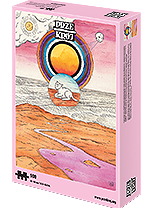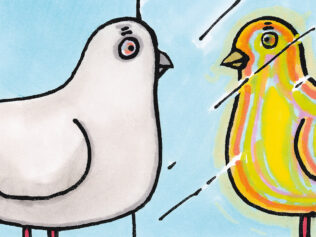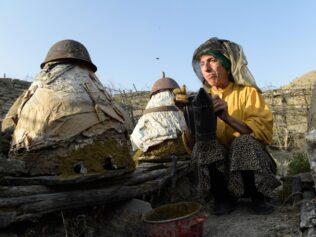
May and June are the months of honeybee migrations: the old queen and part of the colony are searching for a new nesting site. They don’t pick it at random. On the contrary, after considering many options, they make an informed choice together.
The queen isn’t the head of the family. Her task is to lay eggs. The non-fertilized eggs will develop into drones, whereas the fertilized ones will grow into either workers or queen bees, depending on how long the larvae are fed with royal jelly. Those that grow into workers are fed it only for the first three days, while those that become queens live on it throughout the entire larvae stage.

Bee colonies usually split in the spring, when worker bees begin to raise new queens. They create queen cups on the side of the honeycomb, where the queen can lay eggs. Larvae which emerge from them are fed royal jelly by worker bees.
Before the new virgin queen fully develops, workers prepare the old queen to swarm. They jostle and pull her. As a result, her weight is reduced by 25%.

In the meantime, the bees – which are approximately eight-years old and are getting ready for swarming – put on weight. They store honey in their stomachs and reduce any activity to the minimum. The only group that remains active are a few hundred scout bees, which are the most experienced ones, as they have already started the final two weeks of their five-week life. Now, they’re the main decision-makers. One week before the new queen emerges, scout bees signal that they’re about to take off by shaking the lethargic bees.
Then, the bees take flight. The old queen is typically followed by about 50-66% of the colony, i.e. around 10,000 to 30,000 bees. Their first flight is short: they cover a distance of 20-30 metres. They land somewhere near tree branches and form a tight cluster in order not to lose energy. Scouts walk over and fly around the cluster.

The search for a new nesting sites begins. Scouts fly out in all directions. The perfect nest has a volume of 40 litres and is positioned at a height of a few metres. It should have a small entrance area, ideally near the south side. During their search, scouts cover a distance of a few kilometres. If they find a good spot, they share this news with other bees. They return to the hive and communicate it through the so-called ‘waggle dance’, which they usually perform to inform other bees where the food is.

The waggle dance consists of two circuits. First, the bee runs forward on the surface of the tangled swarm, shaking her abdomen. Then, she makes a semi-circular run back to the starting point. During the return run, she moves alternately from the right to the left side. The duration of the first circuit is directly proportional to the length of the journey to the new nesting site found by the scout. The angle of the run, on the other hand, corresponds to the angle of that journey relative to the direction of the sun, while its speed depends on the quality of the site. If it’s low, the bees dance rather sluggishly; if it’s high, their dance is enthusiastic.

Other bees observe and follow the dancing scout bee and then also fly to the chosen location to inspect it. If they like it, they pitch it through waggle dance, too. Scouts can change their mind. But no bee would recommend a nesting site that she hadn’t already inspected.
Sometimes the scouts make a unanimous decision. Other times, they put the matter to a vote and the quorum decides. If a certain number of bees (usually a few dozen) like the same location, the discussion ends. Scouts induce the whole swarm to take flight.

First, they run on the surface of the swarm and press their vibrating thoraxes against other bees to make them vibrate too. This way they warm up, reaching a temperature of 35°C (95°F), which is the minimum for the bees to take off. They signal that they’re all set: while still running, they begin to move their wings. The whole swarm springs up.
Bee scouts, who fly faster, set the direction for the entire swarm, since they’re the only ones who know the location of the new nesting site. Most of the time, bees fly directly to their new home.

In the meantime, in the deserted nest the first new queen bee emerges from the cell. If the colony regains its strength after the swarm, it might want to split again. In this case, the new queen will fly away, taking with her some of the bees. This can happen again, or a couple more times, but such situations are rare.

If the colony doesn’t want to reproduce any more, the last queen stings to death those bees that remain in the cells. If more than one queen emerges from the cells, they fight to death.
The new virgin queen takes her nuptial flight, during which drones from other colonies fertilize her. Thanks to this process, the exchange of genetic material is ensured. This is why the bee colony can be considered a single organism that reproduces in the spring, forming new organisms. Some compare the bee colony to the human brain. Neurons collaborate to make decisions – just like bees, which communicate through pheromones (in the hive) and through dance (outside the hive).

***
The above description applies to honeybees in their natural environment: the wild. Today, most bees in industrialized countries are farming bees. Beekeepers consider swarming a negative phenomenon that complicates their life; as such, they try to prevent it.
We learned how bees make decisions mostly from the works of such scholars as Karl von Frisch, Martin Lindauer and Thomas D. Seeley. The ‘waggle dance’ described here helps the bees to share information about the location of food. Originally, however, it was performed to pick the new nesting site.

In writing this article, I mostly relied on the book Honeybee Democracy by Thomas D. Seeley (Princeton University Press, 2011).
Translated from the Polish by Joanna Mąkowska










